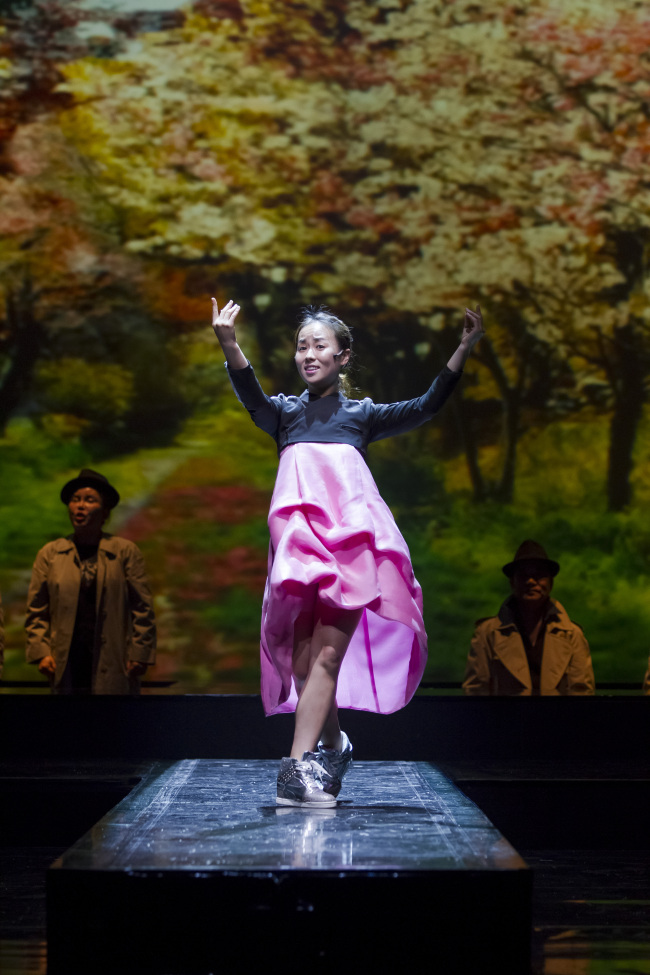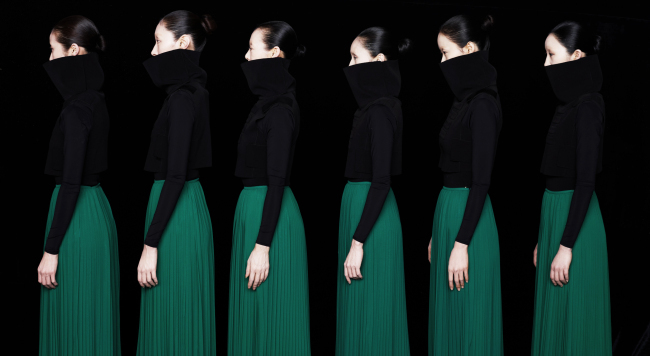Mong-ryong uses his MacBook to study while talking to friends on a smartphone. Chun-hyang wears canvas shoes under her short pink dress. They first meet at a club.
The state-run National Changgeuk Company of Korea’s production of “Different Chunhyang” (2014) by Andrei Serban was very different from any of the previous productions of the classical Korean love story ― between Mong-ryong, the son of a nobleman, and Chun-hyang, the daughter of a low-class retired female entertainer, during the Joseon era (1392-1910).
The state-run National Changgeuk Company of Korea’s production of “Different Chunhyang” (2014) by Andrei Serban was very different from any of the previous productions of the classical Korean love story ― between Mong-ryong, the son of a nobleman, and Chun-hyang, the daughter of a low-class retired female entertainer, during the Joseon era (1392-1910).

New storylines were added and experimental stages were designed for the iconoclastic director’s attempt at “changgeuk,” Korean traditional opera.
A major name in the U.S. and European theaters, Serban was brought in to inject a breath of fresh air into the genre, considered old-fashioned and irrelevant.
“I could not let changgeuk become an antique on display,” the troupe’s artistic director Kim Sung-nyo told The Korea Herald in an interview last November. “I simply wanted to add life and fun to our beautiful tradition.”
Kim is not the only one trying to add a hint of modern taste to time-honored classics.
Collaboration ― between old and new, East and West, and traditional and contemporary ― has become the newest buzzword in the performing arts scene here.
From theatrical plays, stage musicals and dance to music, collaboration is a popular “go to” among renowned directors and playwrights seeking to produce refreshing shows that will appeal to larger audiences.
Here are some of the recent hybrid successes:
The musical play “Gongmudoha (Don’t Cross That River)” established a new genre when it premiered last year. The 120-minute theatrical work included spoken dialogue, dance and all the elements of Korean traditional music ― including “gugak,” folk music.
The show also mixed old and new, using the oldest lyric poem in Korea ― which dates back as far as the 16th century ― to tell the stories of modern-day Korea, including the separation between North and South Korea and the hustle and bustle of city life.

When modern dancer and choreographer Ahn Sung-soo and celebrated fashion designer Jung Ku-ho collaborated with the National Dance Company of Korea ― renowned for its traditional dance repertoire ― the outcome was an experimental work titled “Altar” (2013).
Jung, who has a knack for minimal design, not only dressed the dancers in black turtlenecks and green pleated skirts, but also played “sinawi,” a form of Korean shamanistic music, and Wagner’s opera “Tristan and Isolde” in the background. The two contradicting types of music helped the performance achieve a sense of minimalism.
Tickets sold out to every performance of the NCCK’s changgeuk version of Euripedes’ Greek tragedy “Medea,” both in 2013 and 2014. The intense melodramatic plot was elevated through the unique vocal timbre and trembling emotions of Korean traditional singing.
Even Tchaikovsky’s ballet “The Nutcracker” has been performed here with Korean flavors. Seoul Ballet Theatre annually presents a version of the 122-year-old Russian classic that includes Korean folk dances and “janggu” (Korean drum) performances. Instead of a voluminous dress, the beloved character Mother Ginger ― a giant gingerbread house ― dresses up in a Korean traditional “hanbok” won by queens.
By Ahn Sung-mi (sahn@heraldcorp.com)
-
Articles by Korea Herald









![[Kim Seong-kon] Democracy and the future of South Korea](http://res.heraldm.com/phpwas/restmb_idxmake.php?idx=644&simg=/content/image/2024/04/16/20240416050802_0.jpg&u=)








![[KH Explains] Hyundai's full hybrid edge to pay off amid slow transition to pure EVs](http://res.heraldm.com/phpwas/restmb_idxmake.php?idx=652&simg=/content/image/2024/04/18/20240418050645_0.jpg&u=20240418181020)

![[Today’s K-pop] Zico drops snippet of collaboration with Jennie](http://res.heraldm.com/phpwas/restmb_idxmake.php?idx=642&simg=/content/image/2024/04/18/20240418050702_0.jpg&u=)